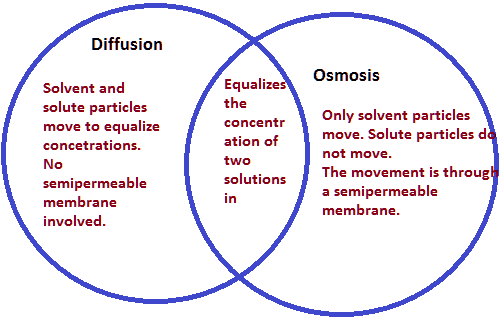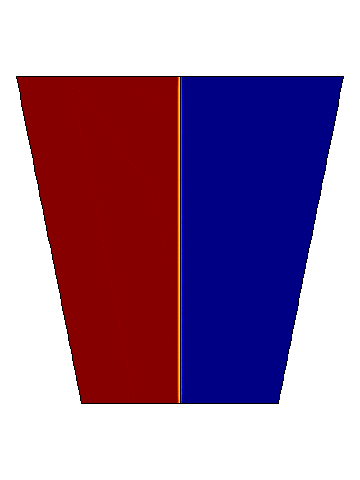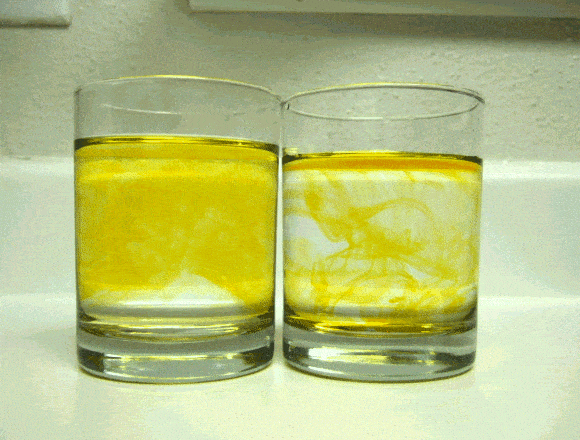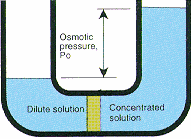What is the Difference Between Diffusion and Osmosis Easy Definition

Diffusion and osmosis are both passive transport processes, meaning they require no energy input to move substances. Both processes are essential to the proper functioning of biological processes such as the transport of water or nutrients between cells.
The main difference between the two is that diffusion can occur in any mixture, even when two solutions aren't separated by a semipermeable membrane, whereas osmosis exclusively occurs across a semipermeable membrane.
There are actually three types of passive transport processes. Besides diffusion and osmosis, there's also facilitated diffusion. While diffusion and osmosis do not involve proteins when transporting substances, facilitated diffusion needs the assistance of proteins.
What's diffusion?

Diffusion is the passive movement of molecules from an area of high concentration of the molecules to an area with a lower concentration. Inside cells, diffusion is the transport of small molecules across the cell membrane.
Molecules are always in motion. Temperature, a physical quality people commonly reference in their daily lives , is directly related to molecular motion. It is a measure of the average kinetic energy of the molecules in a material. The energy of the molecules causes random motion which in turn triggers diffusion. Collisions between molecules are common : even i n the a ir at atmospheric pressu re, a molecule collides with a neighbor every few nanoseconds.
Across the planet, the air inside the atmosphere has the same composition and is comprised of nitrogen (78%), oxygen (about 21%), argon (almost 1%), and other gases like CO 2 that are present in minute quantities (but still enough to warm the planet at an accelerating rate).
Diffusion makes air composition uniform by re distributing chemical species, such as oxygen in the air, until equilibrium is reached : i n other words, until the concentration gradient — the difference in concentration between two areas — has been eliminated. If the concentration of a species is not initially uniform, over tim e d iffusion will cause a mass transfer in favor of a more uniform concentration.

Once in equilibrium, the movement of molecules does not stop because their kinetic energy is the same. There is now an equal movement of chemical species in both directions.
The factors affecting diffusion are:
- concentration gradient;
- temperature;
- distance particles must travel.
Let's look at some examples of diffusion in action. Spraying perfume in a room will make it smell nice for a little while , bu t over time d iffusion will distribute the odor molecules until their concentration is imperceptible to the human nose. Dropping food coloring in a cup of water, which will change the color of the whole solvent (water), is another great example of diffusion
Diffusion is a widespread and important process for both nonliving and living systems. To enter and exit a cell, substances like water or nutrients have to pass through the semipermeable membrane. Diffusion is one of the processes that enable thi s. A semipermeable or selectively permeable membrane is a membrane that allows some substances to pass through easily while other substances travel through very slowly or not at all.
Since diffusion occurs under a variety of conditions, scientists classify several types of diffusion.
- Simple diffusion is the most common kind of diffusion, where substances are transported without the help of proteins.
- Facilitated diffusion requires transport proteins to diffuse substances across a cell's membrane.
- Dialysis is the diffusion of solutes across a selectively permeable membrane.
- Osmosis is usually defined as the diffusion of water, the solvent of choice in all living systems, across a selectively permeable membrane.
What is Osmosis
Osmosis, a type of diffusion, represents the movement of water across a partially-permeable membrane, from an area of high water concentration to an area of low water concentration.
Osmosis takes place in all cells. For instance, when placed in water, red blood cells will let the water creep through their membrane. When placed in a concentrated solution of sugar, the red blood cell actually shrinks because the water moves out by osmosis towards the area of lower water concentration. This is why the cells appear wrinkled when viewed through a microscope. Luckily, this never happens inside the body because the kidneys make sure the concentration of the blood stays about the same as the concentration of the solution inside the red blood cell.
Unlike red blood cells, plant cells have a far stronger and more rigid cell wall on the outside of the cell membrane. This enables the plant cells to absorb more water by osmosis without bursting. Without osmosis, plants wouldn't be able to absorb water from the soil. As more water is absorbed, the cell themselves become rigid due to the pressure — this is very usefu l s ince plants don't have skeletons. If plant cells lose too much water by osmosis , they become less rigid , and eventually , the cell membrane shrinks away from the cell wall.

When osmosis is used to equalize concentrations on both sides of the membrane, it exerts a force called osmotic pressure. For instance, picture two compartments in a tank separated by a semipermeable membrane that only allows water molecules to pass through. One compartment is filled with a salt solution , while the other adjacent compartment is a pure water solution. The only way equilibrium can be reached is by transporting water from the pure water compartment to the saltwater compartment. In doing so, osmosis r a ises the level of liquid in the saltwater compartment until enough pressure caused by the difference in levels between the two compartments stops the processes. The pressure it takes to reach this equilibrium is called the osmotic pressure.
There's also such a thing as reverse osmosis , which is literally the reverse process of osmosis , where the solvent filters out of the high concentrate into the lower concentrate solution. In other words, instead of seeking an equal balance of solvent and solute in both solutions, reverse osmosis separates the solute from the solvent.
Reverse osmosis is very handy for applications like water desalination (removing salt from seawater). Worldwide, there are now over 13,000 desalination plants in the world . In reverse osmosis, we are (literally) just reversing the proces s b y making our solvent filter out of our high concentrate and into the lower concentrate solution , s o instead of creating an equal balance of solvent and solute in both solutions, it is separating out solute from the solvent.
Source: https://www.zmescience.com/science/difference-diffusion-osmosis-043243/
0 Response to "What is the Difference Between Diffusion and Osmosis Easy Definition"
Post a Comment